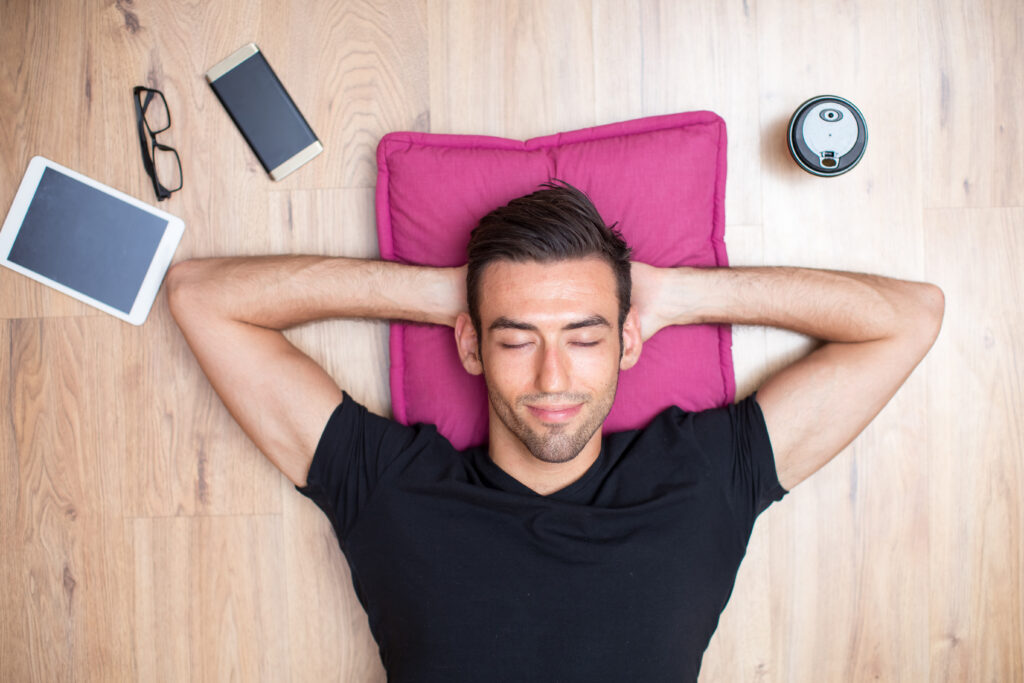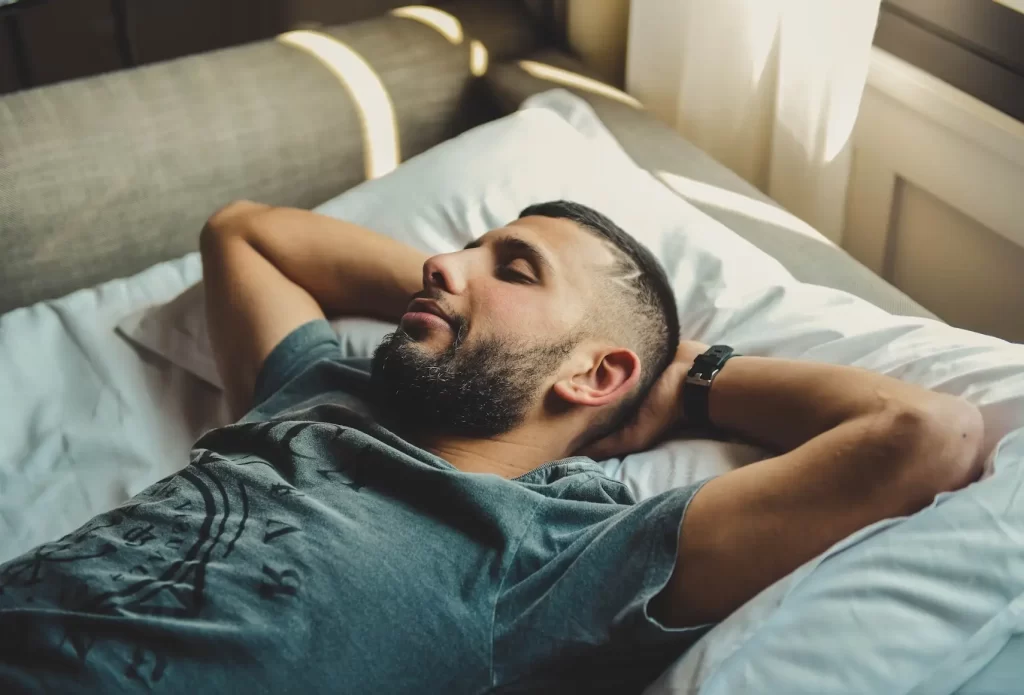Preserving spine health while sleeping is crucial. These tips on how to train yourself to sleep on your back will be very beneficial. Good sleep is vital for best health and well-being, as it allows the body and mind to recharge. Many factors influence the quality of sleep. Good sleep delivers perfect mental focus, better memory, stress control, body weight, immune system, and overall wellness.
However, many people tend to ignore the role of sleep postures in sleep quality. They live with sleep issues without knowing that sleep position is the root of their problem. At the same time, sleeping positions vary from individual to individual.
According to studies, side sleeping is a more popular position in adolescence and adulthood. Tummy sleeping is also a favorite of many people. Children resort to all modes of sleeping: side, stomach, and back sleeping. In Europe, more than 60 percent of adults are lateral or side sleepers.
Nevertheless, experts advocate pursuing the best sleeping positions that take care of spine health, reduce back pain, and promote better breathability and deliver a more restful night.
Why You Should Learn How to Train Yourself to Sleep on Your Back

Among the sleeping positions, back sleeping is the second most popular position. Others include sleeping on your side (lateral) or stomach sleeping.
So, adopting the best sleeping positions brings a world of relief and adequate restorative sleep. The combination of best sleeping positions and best practices in sleep hygiene are considered the backbones of better rest. If that is supplemented with a consistent sleep schedule and a comfortable sleep environment, the sleep quality will double, improving the overall health.
Benefits Of Back Sleeping

The tips to train yourself to sleep on your back matter, as back sleeping, or supine sleeping, offers amazing health benefits. The biggest benefit of sleeping on your back is the best spinal alignment, provided the mattress and pillow are equally supportive.
Experts also add that sleeping on your back will also save you from skin damage such as wrinkles, in contrast to side sleeping or stomach sleeping, where the face presses against the pillow and the resulting pressure develops fine lines and wrinkles.
However, how to train yourself to sleep on your back will need some deliberate training and acclimatization too. This is because it takes some time to change your preferred sleeping position, and there will be a phase of adjustment. However, consistent practice will help you become a back sleeper.
Training For Back Sleeping With The Right Mattress And Pillows.

To start training to sleep on your back as a transition from other sleep positions, make use of the important tools such as supportive mattresses and pillows. The pillow where you rest the head must be good enough to support the natural curve of the incumbent’s neck.
Important points to note in the matter of pillow positioning while lying on your back are having the pillow just under the head and neck.
Sleeping on your back is effective only when there is a supportive mattress with the desired firmness. Also start using a small rounded pillow underneath the neck. Place a flatter pillow under the head. In the former, a memory foam pillow will be the best. Then use a few more pillows for other positions.
Place one under your knees and feel comfortable. This will ensure that your neck and spine are in alignment. Now create a pillow barrier as a physical block to prevent unintended rolling onto the sides or reverting to stomach sleep.
During the training to sleep on your back, use a set of pillows that correctly maintains neck alignment with the mattress. Make sure to avoid pillows that push the neck sideways. In choosing the best pillow, try out pillows of different types and heights before settling for the most comfortable one.
In terms of materials or pillows Memory foam is advised for its comfort and the way it conforms to the shape of the head with better support. Although down pillows are soft, the lack of firmness can be a problem. Latex pillows are good in both support and comfort.
Choose the right mattress: For a comfortable back-sleeping experience, look for a slightly firmer mattress with ample cushioning to ensure spinal alignment. For this, a medium-firm mattress will be fine and give the support and flexibility and not allow the spine to sink too much. Other factors to look at in choosing the mattress include body weight and material type.
Health Benefits From Sleeping On Your Back
Many factors dictate a switch over to back sleeping. Sleeping on the back with both hands at the sides or chest is the best way to prevent pain. Some of the health benefits of back sleeping include the following.
- It keeps the spine better aligned.
- Removes tension headaches
- Reduces pressure on the chest
- Relieves sinus buildup
Improved Breathing And Melatonin From Back Sleeping
When side sleeping or belly sleeping, the crowding of breathing space is not very healthy. The diaphragm is the muscle for breathing, and compressing it leads to shallower breathing. Deep diaphragmatic breathing gives a relaxed mood while waking, as there will be reduced stress, improved mood, and improved attention span.
It has been said slow, deep breathing results in high melatonin production. This hormone promotes relaxation, sleep, and parasympathetic nervous system activity.
This back-sleeping position is akin to standing up straight. In stomach sleeping, the major risk is neck misalignment. Compared to that, back and side sleeping are associated with less spinal pain, especially for adults.
Sleeping On Your Back Offers Skin Protection Too
The biggest benefit of getting trained to sleep on your back is super spinal alignment, provided the mattress and pillow are equally supportive. Experts also add that sleeping on your back will also save you from skin damage such as wrinkles, in contrast to side sleeping or stomach sleeping, where the face presses against the pillow and the resulting pressure develops fine lines and wrinkles.
Better hygiene: Sleeping on your face can pull and irritate the skin, and wrinkles follow. The neck also suffers from scrunching while sleeping on your stomach. It is not hygienic, either; the pillowcases absorb sebum from the skin and hair and pass it on to the face while sleeping, causing skin issues such as blackheads, whiteheads, redness, and irritation. Since back sleeping keeps the face away from the pillowcase, the dirt and oils will never attack.
Improve Cycles Of Sleep With Right Positions
While planning the tips to train yourself to sleep on your back, understand that sleep consists of many stages. The two main categories of sleep are non-REM and REM sleep. Non-REM sleep is the primary stage and the lightest too. Here a person drifts in and out of sleep with heart rate slowing and body temperature showing dips. This helps in physical recovery. As deep sleep sets in, it helps in tissue growth and repair, memory consolidation, and energy restoration.
It is the REM sleep that involves hectic brain activity, including dreaming, leading to emotional regulation and healthy memory processing. Any healthy sleep cycle will involve these stages each night.
How To Improve The Quality Of Sleep
After attaining the expertise to sleep on your back, look at improving other factors that can enhance the quality of sleep, such as good habits and sleep hygiene. Some good habits to enjoy a sound sleep will include these elements too.
- Going to bed and waking up at the same time every day
- Going to bed early to have at least 7 hours of sleep
- A relaxing nighttime including a warm bath or reading before bedtime
- Use the bed only for sleep and sexual union.
- Keep the bedroom quiet, relaxing, cool, and comfortable.
- Switch off all electronic gadgets 30 minutes before bedtime.
- Avoid taking alcohol before bedtime.
When To Avoid Back Sleep
At the same time, sleeping on the back can have issues with people who snore excessively or face sleep apnea or repeated pauses in breathing during sleeping.
People suffering from obstructive sleep apnea (OSA) are not encouraged to do back sleeping. Pregnant women in their third trimester must also skip sleeping on their back because it can reduce blood flow to the foetus, and for them, the side sleep position will be better.
To conclude
To cut the story short, awareness about best sleeping positions is the key to achieving quality sleep each night. The efforts at how to train yourself to sleep on your back and getting rid of habituated side or stomach sleep positions will pay off in the short and medium terms with better dynamism backed by the best spine health and zero back pain.
Frequently Asked Questions
Q1. Why is back sleeping advised by experts?
Foremost is better spinal alignment. Another advantage is the reported relief for lower back pain. Many people also vouch for better breathing during back sleep. Sleeping on the back keeps the neck and back tension-free, and the scope of tension-related headaches is contained.
Q2. Why pregnant women are not encouraged for back sleep?
Pregnant women, especially in the third trimester, are advised against back sleeping as it escalates pressure on the heart and other organs. It may also restrict blood flow to the uterus.
Q3. What are the important tips to train yourself to sleep on your back?
For effective back sleeping, the right mattress and pillow help. A medium-firm mattress is ideal for proper spinal alignment. Those in the habit of snoring can raise the head a bit with an extra pillow or use an inclined pillow.
Q4. Why is back sleeping strictly advised for toddlers and infants?
For babies, back sleeping is a must right from birth until the baby is 12 months of age. Back sleeping saves from the risk of Sudden Infant Death Syndrome (SIDS). That is why parents are advised to place babies on their backs for sleep even if they can roll over to other positions. After the first birthday, any sleep position will be fine for the baby.




